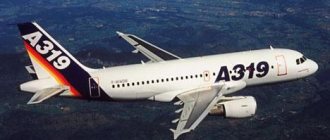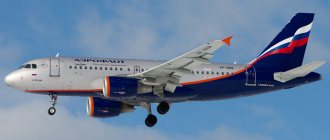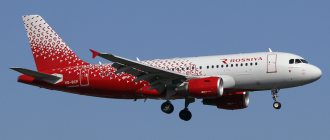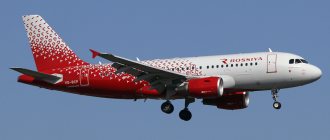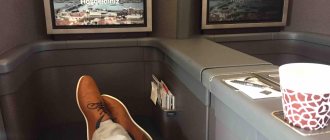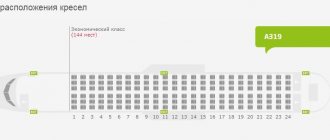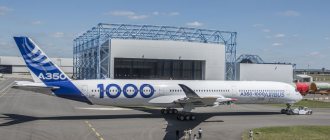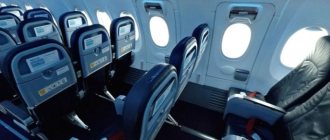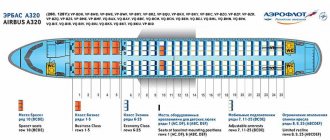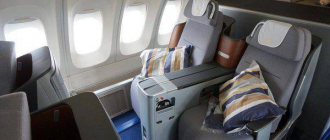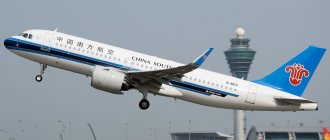| S7 Airlines Ural Airlines Russia Czech Airlines Aurora Reviews of Airbus A319 |
The Airbus A319 is part of the A320 family of airliners, has a shortened fuselage and is used for passenger transportation over short and medium distances - up to 6900 km or up to 8300 km when modified by the A319LR. Onboard capacity is from 116 to 158 passengers, depending on the selected configuration.
This Airbus is popular with airlines from all over the world. The largest operator is the British low-cost airline EasyJet. In Russia, Airbus A319 aircraft are regularly operated by S7 Airlines, Ural Airlines, Rossiya, and Aurora.
© Aktug Ates Gallery page, , GFDL 1.2, commons.wikimedia.org
Below are diagrams of Airbus A319 cabins on the most popular airlines among Russian-speaking passengers.
History of creation
In 1987, the first tests of the new medium-haul passenger aircraft Airbus A320 took place. The results showed that it was ready for operation, and within a year the airliner began operating regular flights. Having gained more experience, the aircraft manufacturer began to think about developing another aircraft.
According to their plan, it should have been in the same class as the A320, but be a little shorter and have an increased amount of fuel on board. The project began to be prepared in 1990. For two years, the designers worked out all the nuances, conducted research and calculated the capabilities of the future machine. When it became clear that the project would be implemented, the company officially announced it and named the new aircraft the Airbus A319.
The prototype began to be built only in June 1993 at the French and German Airbus factories. The company was confident in the success of its project. According to preliminary estimates, the aircraft had every chance of becoming a serious competitor to the Boeing 737 and MD-87. Some experts believed that the A319 could even undermine the interests of other aircraft manufacturers by taking a leading position in this class of civil aviation.
The aircraft was tested quickly, so by March 1996, the Airbus A319 had already received all the necessary certificates. A month later, the airliner made its first scheduled flight, demonstrating its technical qualities.
Attention to the A319 has increased to such an extent that the airline has had to ramp up production to cope with high demand. The available factories in France and Germany were no longer enough, so a new branch was opened in China. The wings were made in Berlin, body parts are created in Stade, some elements are produced in Toulouse, and final assembly takes place in Hamburg and Tianjin.
Since 2016, the standard version of the aircraft has been removed from the assembly line and will no longer be produced. It was replaced by the updated A319neo. In total, less than a hundred new airliners were produced, but the number of orders is gradually increasing.
Notes
- orders & deliveries A220/A320
- Airbus Aircraft 2014 Average Price List Archived February 3, 2014.
- ↑ 12345
Victor Belyaev. Passenger aircraft of the world. - ↑ 12345
V. Korneev. Airplane A320. Analysis of design and flight operation. - Hamburger Abendblatt: Airbus baut erstmals den A320 in Hamburg
, 26. März 2008 - Vier Flugzeuge der A320-Familie werden in Zukunft pro Monat in China endmontiert (inaccessible link)
- FlightGlobal: Airbus raising monthly A320 production to 42 next year
, 18 May 2011 - "Cessna Unveils 'Baby' Citation Mustang" Archived September 25, 2007 on the Wayback Machine Archived September 25, 2007. Correspondent: Laura Magomedova “Business Petersburg” ISSN 1606-1829 (Online) August 20, 2007
- ↑ 123
A320 NEO to have $7—8 million price premium Flightglobal - SINGAPORE 2010: Airbus targets early A320 re-engining decision, 2015 debut Flightglobal
- Airbus to Deploy Superjumbo, Military Engineers for A320 NEO Bloomberg
- TAM becomes first A320neo customer in Latin America | INTERNATIONAL AVIATION NEWS (unspecified)
. Aviationnews.eu (28 February 2011). Access date: June 26, 2011. Archived February 5, 2012. - Airbus A320 Aircraft family (unspecified)
. Airbus.com (25 June 2011). Access date: June 26, 2011. Archived February 5, 2012. - [1]. Virgin America Press Release
- Wall, Robert.
IndiGo Becomes First A320NEO Customer With Huge Order
(unspecified)
. Aviation Week (January 12, 2011). Access date: June 9, 2011. - Ranson, Lori.
IndiGo's potential A320neo order heats up engine competition
(undefined)
. Air Transport Intelligence news via Flightglobal.com (11 January 2011). Access date: June 9, 2011. Archived February 5, 2012. - Airbus secures 80 orders for A320NEO. Airbus official website.
- "PARIS: IndiGo firms A320 MOU".
- “Airbus gets the biggest plane order ever to handily outpace Boeing in race to the industry's top spot” Archived copy dated June 10, 2022 on the Wayback Machine. Washington Post, 23 June 2011.
- Source for expense: Helmut Kreuzer: Moderne Verkehrsflugzeuge und Business Jets
, ISBN 3-9805934-0-1 - Harro Ranter.
Aviation Safety Network > ASN Aviation Safety Database > Type index > ASN Aviation Safety Database results
(unspecified)
.
aviation-safety.net
. Access date: June 28, 2022. - Harro Ranter.
Aviation Safety Network > ASN Aviation Safety Database > Aircraft type index > Airbus A320 > Airbus A320 Statistics
(unspecified)
.
aviation-safety.net
. Access date: June 28, 2022. - The pilot of a Chinese airliner almost flew out of the cockpit at an altitude of 10 km (Russian). BBC News Russian Service
. Access date: June 28, 2022.
Airbus A319 interior diagram
The cabin width of the A319 is 3.7 m, which is enough to accommodate six seats in each row of economy class. They are located in threes on both sides, and there is a passage between them. In business class, there are two seats on the left and two on the right. In the A319, the airline's cabin layout is customized to suit itself.
Airbus A319 interior diagram
Therefore, various combinations are possible in one-class and two-class layouts. For all variations on board, toilets are installed in the front and rear sections of the cabin. The bow compartment also has a technical room.
The most common option is with 8 business class seats, where 120 seats are allocated for economy. The single-class layout for 156 people is also common - it has the largest passenger capacity.
The cabin version for 144 seats also received only economy class, differing from the previous one in the free space. Another layout implies the presence of 116 seats, 20 of which are allocated for business class. It is used by Russian aviation.
The choice of good seats depends on the type of cabin on the plane. They can be determined based on the location of the seats relative to the body elements.
Best Business Class Seats
The business class of the Airbus A319 creates comfortable conditions for all passengers. It has soft reclining seats and built-in entertainment systems. The total number of such seats, if provided, varies from 4 to 20. These seats are separated from economy class by a special partition.
All seats provide passengers with the highest level of comfort. An exception may be the first row. It has the most legroom, but sometimes creates minor inconveniences. Therefore, when purchasing a ticket, it is recommended to give preference to seats starting from the second row.
Best Economy Class Seats
Economy class seats are characterized by reduced comfort, smaller sizes and more dense placement. Each row consists of six seats, and the width of the aisle in the middle is only 80 cm. Economy includes from 96 to 156 seats. Comfortable seats may be located in different rows, depending on the aircraft layout. But you can determine them yourself, simply by paying attention to their placement relative to the elements of the airliner body.
The best seats on the Airbus A319 in economy class are considered to be seats B, C, D and E, located in row 9. They are located immediately after the escape hatch, which gives them certain advantages. Passengers receive more free legroom, while the proximity to small children and animals is completely excluded, since they are prohibited from being located here. For other layouts, seats may be on the 8th, 9th, 10th or 11th row.
The very first economy seats are considered a little less comfortable. This could be the 3rd or 6th row; there is a wall in front of it, which creates some visual discomfort, but the large free space compensates for this disadvantage.
Also, passengers from this row are the first to have the opportunity to choose their food and drinks. An additional advantage can be considered a reduction in the overall noise level from the engines.
Bad places
The first row of business class is very comfortable, but has one serious drawback - its location. There is a toilet in front of it, where people constantly go. There may be an unpleasant odor coming from there, and noise is possible. Even more inconvenient is the queue.
In economy class, the seats in front of the emergency exits are inconvenient. They can be located on the 7th, 8th, 9th or 10th row. The main drawback of these chairs is the inability to recline the backrest for relaxation. Also, some consider the 3rd or 6th row seats uncomfortable, which are classified by the majority as comfortable. The point is that there is a possibility of proximity to children, since it is the first row of economy that is equipped with cradles. This disadvantage is considered individual and conditional.
The worst economy seats are located in rows 21 and 22. Toilets are located immediately after them, which creates many inconveniences for passengers, including noise, unpleasant odors, burning lights and queues.
The seats on the 22nd row are also distinguished by the inability to recline the backrest, as they are close to the wall. You can buy tickets for these seats only in extreme cases, when there is nothing to choose from, but you need to fly.
Literature
- Aris, Stephen.
Close to the Sun (undefined). - London, UK: Aurum Press Ltd, 2002. - ISBN 978-1-85410-830-2. - Eden, Paul E. (general editor).
Civil Aircraft Today (unspecified). - London: Amber Books, 2008, 2008. - ISBN 978-1-905704-86-6. - Gunston, Bill.
Airbus: The Complete Story (undefined). - Sparkford, Yeovil, Somerset, UK: Haynes Publishing (English) (Russian, 2009. - ISBN 978-1-84425-585-6. - Norris, Guy and Mark Wagner.
Airbus (undefined). — St. Paul, Minnesota: MBI Publishing (English) (Russian, 1999. - ISBN 978-0-7603-0677-2. - Reed, Arthur.
Airbus: Europe's High Flyer (undefined). - Zürich, Switzerland: Norden Publishing House, 1992. - ISBN 978-3-907150-10-8.
Flight performance
The A319 became a smaller version of the A320, so they are similar to each other. The aircraft has a length of 33.8 m and a height of 11.8 m. The wing area is 122.4 m² with a span of 34.1 m. When empty, the model weighs 40.3 tons, and the payload should not exceed 17.9 tons. At takeoff, an airliner can have a mass of up to 75.5 tons, and when landing - up to 62.5 tons.
Flight performance
The technical characteristics of the A319 aircraft are largely provided by two engines. CFM56-5A/5B or IAE V2500-A5 can be used. The thrust of both is 10,700 kgf. The airliner accelerates to 890 km/h, cruising speed is 820 km/h. At maximum loads it flies up to 4,700 km, at medium loads – up to 6,800 km. The service ceiling is limited to 11900 m. When taking off, the aircraft requires an acceleration of 1520 m, and when landing it will need a run of up to 1450 m.
Specific fuel consumption is 20.5 g/pass.-km. Sentry - 2600 kg. The volume of the tanks can reach 29,840 liters. The exact capacity depends on the aircraft modification and the airline's requirements.
Supplies
| Orders | Supplies | |||||||||||||||||||||||||||||||
| Type | Total | Unfulfilled | Total | 2016 | 2015 | 2014 | 2013 | 2012 | 2011 | 2010 | 2009 | 2008 | 2007 | 2006 | 2005 | 2004 | 2003 | 2002 | 2001 | 2000 | 1999 | 1998 | 1997 | 1996 | 1995 | 1994 | 1993 | 1992 | 1991 | 1990 | 1989 | 1988 |
| A318 | 80 | 80 | 1 | 1 | 2 | 2 | 2 | 6 | 13 | 17 | 8 | 9 | 10 | 9 | ||||||||||||||||||
| A319 | 1472 | 17 | 1455 | 2 | 24 | 34 | 38 | 38 | 47 | 51 | 88 | 98 | 105 | 137 | 142 | 87 | 72 | 85 | 89 | 112 | 88 | 53 | 47 | 18 | ||||||||
| A320 | 4761 | 519 | 4242 | 110 | 282 | 306 | 352 | 332 | 306 | 297 | 221 | 209 | 194 | 164 | 121 | 101 | 119 | 116 | 119 | 101 | 101 | 80 | 58 | 38 | 34 | 48 | 71 | 111 | 119 | 58 | 58 | 16 |
| A321 | 1684 | 400 | 1284 | 73 | 184 | 150 | 102 | 83 | 66 | 51 | 87 | 66 | 51 | 30 | 17 | 35 | 33 | 35 | 49 | 28 | 33 | 35 | 22 | 16 | 22 | 16 | ||||||
| Total | 7997 | 936 | 7061 | 185 | 491 | 490 | 493 | 455 | 421 | 401 | 402 | 386 | 367 | 339 | 289 | 233 | 233 | 236 | 257 | 241 | 222 | 168 | 127 | 72 | 56 | 64 | 71 | 111 | 119 | 58 | 58 | 16 |
Data as of end of May 2016
Design
The airliner is a narrow-body, low-wing, twin-engine aircraft with a swept wing. The use of such a scheme makes it possible to increase the safety of passengers during an emergency landing. If the plane hits the ground, the design of the wing will protect people from serious injury.
Composite materials were actively used in the production of elements of the Airbus A319 aircraft, as is the case with the A320. This decision had a positive impact on performance and helped reduce the overall weight of the airliner, leaving more room for payload. The three-wheel chassis is characterized by increased strength and low weight, which simplifies its operation and reduces the load on hydraulics.
The airliner's engines are located under the wing near the fuselage. They are turbofans and provide sufficient power to perform all necessary maneuvers. There are advanced electronic EFIS systems on board. Pilots receive information from color multifunction displays, and the aircraft is controlled using special joysticks that replace classic steering wheels.
Models and modifications
The introduction of the A320 and its derivatives, including the A319, helped Airbus Industrie offset the financial costs of developing and producing the larger A380 airliners. The shortened version received its own models, differing in certain criteria.
This made her even more popular and in demand. Each carrier can choose the set of characteristics and features that it needs. Therefore, the Airbus A319-100 began to receive separate modifications, further expanding the choice for customers.
Aircraft produced:
- A319-110 – improved version with CFM56-5 engines;
- A319-111 – modification on CFM56-5A4 engines;
- A319-112 – third version on new CFM56-5B4 engines;
- A319-114 – model with engines replaced by CFM56-5B6;
- A319-130 – a new version of the aircraft with AeroEngines V engines;
- A319-LR - a modified model with an increased flight range of up to 8000 km, received additional fuel tanks;
- A319-CJ – business version of the aircraft with an extended flight range, used for business visits;
- A319-ACJ – redesigned A319-CJ with a capacity of up to 50 people and the ability to fly up to 12,000 km;
- The A319neo is the latest modification of the aircraft with improved performance and new electronics on board.
Most airlines use basic versions. In recent years, they have begun to be partially replaced by the new A319neo, but many carriers prefer to keep both versions of the aircraft in service.
Analog aircraft
The main competitors for the A320 family are aircraft from the Bombardier CS 300 and . The Boeing 757 competes with the A321 with a slightly longer range and slightly larger passenger capacity, but was discontinued in 2005. For the A318 and A319 models, rival models may be legacy variants such as the discontinued Boeing 717.
The Soviet Tu-154 aircraft, having similar parameters, spends more kerosene on transporting each passenger, even in the latest modification of the Tu-154 M
, and therefore cannot withstand commercial competition. The newer Tupolev model - 204/214 - is generally comparable to the A321 in terms of commercial efficiency, but was produced in small quantities (less than a hundred cars) and has now actually been discontinued, so it also cannot be considered as a serious competitor.
Operating airlines
The first airlines to take the A319 into service were the French Air France and the German Air Berlin. A little later, Lufthansa, Eurowings, Turkish Airlines and Czech Airlines replenished their fleets with these airliners.
After this, the aircraft began to be actively purchased by many other European airlines for regular flights. A few years later, even Canadian and American carriers took it into operation. The airliner is used in limited quantities by small countries, including Nigeria, Gambia and Qatar.
In Russia, the A319 is used by several airlines, Rossiya and S7. It is also in the fleet of the I Fly company, which operates charter flights for various tour operators. Previously, the aircraft was used on regular Aeroflot flights, but in 2016 the airline decided to withdraw the A319 from service, replacing it with newer and safer airliner models.
The popularity of the A319 is associated with its advanced characteristics, which are expressed not only in flight performance, but also in the level of safety. The model turned out to be somewhat cheaper than the older version represented by the A320, which is why it attracted attention. The main task assigned to the company was completed - the aircraft became a serious competitor to the Boeing 737 and even forced it out of the market in certain countries. Therefore, the creation of the A319 is considered the most important decision of Airbus.
Manufacturer
The airline Airbus SAS was created in the late 60s of the last century and is considered the largest aircraft manufacturing concern in the world. For the information of readers, in English the name of the airliner is pronounced as airbus or airbus, and in French - erbus. Passenger, transport and military transport aircraft are produced under the Airbus marking. The final assembly of the aircraft is carried out at production facilities located in the French city of Toulouse and in Germany, the city of Hamburg.
During the existence of the company, 2,000 similar airliners were built and put into operation; the cost of one A319 aircraft is equal to $86 million.
